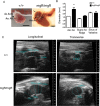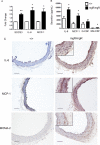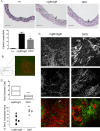IL-6 regulates extracellular matrix remodeling associated with aortic dilation in a fibrillin-1 hypomorphic mgR/mgR mouse model of severe Marfan syndrome
- PMID: 24449804
- PMCID: PMC3959679
- DOI: 10.1161/JAHA.113.000476
IL-6 regulates extracellular matrix remodeling associated with aortic dilation in a fibrillin-1 hypomorphic mgR/mgR mouse model of severe Marfan syndrome
Abstract
Background: Development of thoracic aortic aneurysms is the most significant clinical phenotype in patients with Marfan syndrome. An inflammatory response has been described in advanced stages of the disease. Because the hallmark of vascular inflammation is local interleukin-6 (IL-6) secretion, we explored the role of this proinflammatory cytokine in the formation of aortic aneurysms and rupture in hypomorphic fibrillin-deficient mice (mgR/mgR).
Methods and results: MgR/mgR mice developed ascending aortic aneurysms with significant dilation of the ascending aorta by 12 weeks (2.7 ± 0.1 and 1.3 ± 0.1 for mgR/mgR versus wild-type mice, respectively; P<0.001). IL-6 signaling was increased in mgR/mgR aortas measured by increases in IL-6 and SOCS3 mRNA transcripts (P<0.05) and in cytokine secretion of IL-6, MCP-1, and GM-CSF (P<0.05). To investigate the role of IL-6 signaling, we generated mgR homozygous mice with IL-6 deficiency (DKO). The extracellular matrix of mgR/mgR mice showed significant disruption of elastin and the presence of dysregulated collagen deposition in the medial-adventitial border by second harmonic generation multiphoton autofluorescence microscopy. DKO mice exhibited less elastin and collagen degeneration than mgR/mgR mice, which was associated with decreased activity of matrix metalloproteinase-9 and had significantly reduced aortic dilation (1.0 ± 0.1 versus 1.6 ± 0.2 mm change from baseline, DKO versus mgR/mgR, P<0.05) that did not affect rupture and survival.
Conclusion: Activation of IL-6-STAT3 signaling contributes to aneurysmal dilation in mgR/mgR mice through increased MMP-9 activity, aggravating extracellular matrix degradation.
Keywords: Marfan syndrome; extracellular matrix; interleukin‐6; matrix metalloproteinases; mgR; thoracic aortic aneurysms and dissections; vascular inflammation.
Figures






Similar articles
-
Doxycycline delays aneurysm rupture in a mouse model of Marfan syndrome.J Vasc Surg. 2008 Jan;47(1):166-72; discussion 172. doi: 10.1016/j.jvs.2007.09.016. J Vasc Surg. 2008. PMID: 18178469 Free PMC article.
-
Antagonism of GxxPG fragments ameliorates manifestations of aortic disease in Marfan syndrome mice.Hum Mol Genet. 2013 Feb 1;22(3):433-43. doi: 10.1093/hmg/dds439. Epub 2012 Oct 24. Hum Mol Genet. 2013. PMID: 23100322
-
Redox Dysregulation of Vascular Smooth Muscle Sirtuin-1 in Thoracic Aortic Aneurysm in Marfan Syndrome.Arterioscler Thromb Vasc Biol. 2023 Aug;43(8):e339-e357. doi: 10.1161/ATVBAHA.123.319145. Epub 2023 Jun 8. Arterioscler Thromb Vasc Biol. 2023. PMID: 37288573 Free PMC article.
-
Elastic and collagenous networks in vascular diseases.Cell Struct Funct. 2000 Apr;25(2):69-72. doi: 10.1247/csf.25.69. Cell Struct Funct. 2000. PMID: 10885576 Free PMC article. Review.
-
Microfibrils: a cornerstone of extracellular matrix and a key to understand Marfan syndrome.Ital J Anat Embryol. 2009 Oct-Dec;114(4):201-24. Ital J Anat Embryol. 2009. PMID: 20578676 Review.
Cited by
-
Cytokine amplification and macrophage effector functions in aortic inflammation and abdominal aortic aneurysm formation.J Thorac Dis. 2016 Aug;8(8):E746-54. doi: 10.21037/jtd.2016.06.37. J Thorac Dis. 2016. PMID: 27619163 Free PMC article.
-
Anatomically specific reactive oxygen species production participates in Marfan syndrome aneurysm formation.J Cell Mol Med. 2019 Oct;23(10):7000-7009. doi: 10.1111/jcmm.14587. Epub 2019 Aug 11. J Cell Mol Med. 2019. PMID: 31402541 Free PMC article.
-
Interleukin-18 Expression Increases in the Aorta and Plasma of Patients with Acute Aortic Dissection.Mediators Inflamm. 2019 Jul 22;2019:8691294. doi: 10.1155/2019/8691294. eCollection 2019. Mediators Inflamm. 2019. PMID: 31427887 Free PMC article.
-
Targeting the Extracellular Matrix in Abdominal Aortic Aneurysms Using Molecular Imaging Insights.Int J Mol Sci. 2021 Mar 7;22(5):2685. doi: 10.3390/ijms22052685. Int J Mol Sci. 2021. PMID: 33799971 Free PMC article. Review.
-
Salivary and serum asprosin hormone levels in the 2018 EFP/AAP classification of periodontitis stages and body mass index status: a case-control study.Clin Oral Investig. 2024 Jan 13;28(1):91. doi: 10.1007/s00784-024-05494-9. Clin Oral Investig. 2024. PMID: 38217801 Free PMC article.
References
-
- Dietz HC, Loeys B, Carta L, Ramirez F. Recent progress towards a molecular understanding of Marfan syndrome. Am J Med Genet C Semin Med Genet. 2005; 139C:4-9 - PubMed
-
- Williams A, Davies S, Stuart AG, Wilson DG, Fraser AG. Medical treatment of Marfan syndrome: a time for change. Heart. 2008; 94:414-421 - PubMed
-
- Yetman AT. Cardiovascular pharmacotherapy in patients with Marfan syndrome. Am J Cardiovasc Drugs. 2007; 7:117-126 - PubMed
-
- Hirata K, Triposkiadis F, Sparks E, Bowen J, Wooley CF, Boudoulas H. The Marfan syndrome: abnormal aortic elastic properties. J Am Coll Cardiol. 1991; 18:57-63 - PubMed
-
- Dietz HC, Pyeritz RE. Mutations in the human gene for fibrillin‐1 (FBN1) in the Marfan syndrome and related disorders. Hum Mol Genet. 1995; 4 Spec No:1799-1809 - PubMed
Publication types
MeSH terms
Substances
Grants and funding
LinkOut - more resources
Full Text Sources
Other Literature Sources
Medical
Molecular Biology Databases
Miscellaneous

